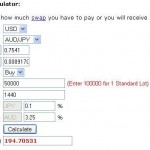Trading the Carry Trade

The carry trade strategy involves profiting from interest rate differentials in addition to earning from the Forex trade itself. The carry trade strategy aims to make money from the differences in interest rates by taking a long position on a high interest currency while simultaneously selling a low interest currency. Overnight positions on such currency pairs that pair currencies with significant interest rate differentials earn money on rollover swap.
The trader who is looking at making money from such interest rate differentials has to pick out currencies that have such a differential, get the appropriate pairing from the Forex platform and place the trade, going long on the base currency if it has a higher interest, or going short on the base currency if it has the lower interest rate.
For instance, the AUD, NZD and CAD are the major currencies with higher interest rates than their peers in the Forex market, all having interest rates above 3%. The GBP, EUR, JPY and USD all have interest rates lower than 1%. So in the EURAUD currency pair where the interest rate differential is 2.5% (0.75% for Euro and 3.25% for Australian Dollar), the strategy is to go short on the EURAUD. In the case of the AUDUSD currency pair where the interest rate differential is in favour of the base currency, the trader will assume a long position on the pairing.
The History of Carry Trades
In the decade stretching from 1997 to 2007, and with interest rates in Japan falling to very low levels and those of the Oceanic countries (Australia and New Zealand) rising to record levels, traders pounced on the AUDJPY and NZDJPY currency pairings, propelling the AUDJPY from just above 55 Yen to 1 Australian Dollar to more than 107 Yen to the Australian Dollar, before the global financial crisis forced the cutting of interest rates in the developed world and the unwinding of the carry trade strategy.
Fortunately Australia was partially insulated from the effects of the global financial crisis. With its major trade partners like China doing well economically, the Australian economy was not as badly hit by the meltdown as those of the the US and the Euro-zone. Interest rates are therefore climbing again while those of the US and Japan remain firmly rooted at less than 0.1%, providing new opportunities for the carry trade.
The Modern Day Carry Trade
How is a modern-day retail trader expected to trade the carry trade? This can be summarized in the following steps:
a) Identify a liquid carry trade currency pair to trade. Recommended pairs are the AUDUSD, AUDJPY and EURAUD.
b) Understand that a carry trade position must be held for at least a few weeks to months to make the trader significant money from the interest rate differential.
c) Understand that the aim is also to make money from capital appreciation on the carry trade currency, driving a two-pronged earning strategy from the carry trade.
d) Using (b) and (c) above, look for opportunities to trade the carry trade currency pairs for the long term, using the daily chart for analysis.
Example of a Carry Trade
Earning from a carry trade is done in two ways:
a) From the interest rollover swap payments made into the account daily.
b) From the capital appreciation on the trade.
A trader named Uncle John decides to trade the carry trade strategy on the AUDJPY, placing a long trade with 0.5 lots at 75.50 and exits the trade at 83.00, making a gain of 750 pips. How much has he earned from the carry trade?
a) Profit on the capital appreciation on the trade:
For the AUDJPY, a pip on a Standard Lot is equivalent to $12.75. So the profit from the capital appreciation is [(12.75/2) X 750] = $4,781.25.
b) From interest rollover: The daily interest rate differential on this trade is (3.25 (AUD) – 0.1 (Japan).
Using the swap rollover calculator on Forexoma as shown below, the trader would earn about $194.71 in swap for holding the position open for 60 days (1440 hours).
Total profit from the trade = 4,781.25 + 194.71 = $4,975.96. So there you have it – give it a try!


